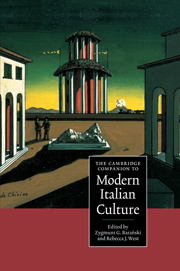Book contents
- Frontmatter
- Introducing modern Italian culture
- 1 The notion of Italy
- 2 Social and political cultures in Italy from 1860 to the present day
- 3 Questions of language
- 4 Intellectuals, culture and power in modern Italy
- 5 Catholicism
- 6 Socialism, Communism and other ‘isms’
- 7 Other voices: contesting the status quo
- 8 Narratives of self and society
- 9 Searching for new languages: modern Italian poetry
- 10 Drama: realism, identity and reality on stage
- 11 Italian cinema
- 12 Art in modern Italy: from the Macchiaioli to the Transavanguardia
- 13 A modern identity for a new nation: design in Italy since 1860
- 14 Fashion: narration and nation
- 15 The media
- 16 Since Verdi: Italian serious music 1860-1995
- 17 Folk music and popular song from the nineteenth century to the 1990s
- 18 Epilogue: Italian culture or multiculture in the new millennium?
- Index
- Series List
11 - Italian cinema
Published online by Cambridge University Press: 28 May 2006
- Frontmatter
- Introducing modern Italian culture
- 1 The notion of Italy
- 2 Social and political cultures in Italy from 1860 to the present day
- 3 Questions of language
- 4 Intellectuals, culture and power in modern Italy
- 5 Catholicism
- 6 Socialism, Communism and other ‘isms’
- 7 Other voices: contesting the status quo
- 8 Narratives of self and society
- 9 Searching for new languages: modern Italian poetry
- 10 Drama: realism, identity and reality on stage
- 11 Italian cinema
- 12 Art in modern Italy: from the Macchiaioli to the Transavanguardia
- 13 A modern identity for a new nation: design in Italy since 1860
- 14 Fashion: narration and nation
- 15 The media
- 16 Since Verdi: Italian serious music 1860-1995
- 17 Folk music and popular song from the nineteenth century to the 1990s
- 18 Epilogue: Italian culture or multiculture in the new millennium?
- Index
- Series List
Summary
Italian silent cinema
On 11 November 1895, Filoteo Albertini applied for a patent on the Albertini Kinetograph, and between 1909 and 1916, the Italian silent cinema represented a major force in world cinema before the hegemony of Hollywood was firmly established. Albertini produced the first feature film with a complex plot - La presa di Roma ('The Taking of Rome', 1905) - a treatment of a patriotic theme, the annexation of the Eternal City to the new Italian state in 1870. The next year, a major production company, CINES, was founded, which enabled Italian films to capture the world market for a brief period. While Italian silent films reflected a variety of genres - Roman costume dramas, adventure films, comedies, filmed drama, even experimental, avant-garde works - the industry's most popular product was the costumed film set in classical antiquity. The period's greatest director was Giovanni Pastrone (1883-1959), whose majestic silent classic Cabiria (1914) established the popularity of the feature film with its depiction of the Second Punic War and influenced D.W. Griffith's Intolerance (1916).
- Type
- Chapter
- Information
- The Cambridge Companion to Modern Italian Culture , pp. 215 - 242Publisher: Cambridge University PressPrint publication year: 2001
- 18
- Cited by

